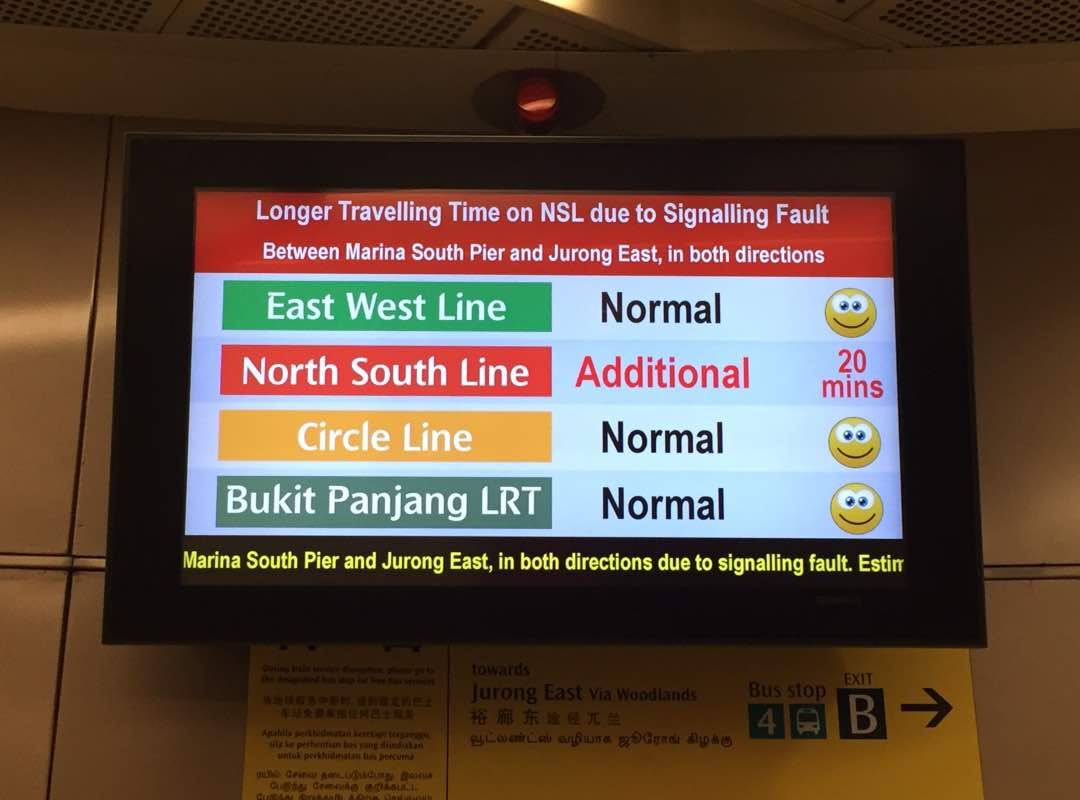If you were among the hoi polloi who has ever been caught in an MRT breakdown (and odds are you would have), you'll be curious (to put it mildly) about the workings of our transport system.
Especially, for instance, last week, when we saw our North South Line go down on two consecutive peak-hour evenings, ostensibly due to "signalling checks".
On Wednesday, SMRT published a blog post to answer a number of burning questions us MRT-riding plebeians all have.
In view of last week's faults on the North South Line, the first and most pertinent question we're gonna tackle is:
Why must performance checks on the signalling system be carried out during peak hours? Can’t they be done after train services have ceased, or on weekends?
TL;DR: When a new signalling system is introduced to an entire network, a whole fleet of existing trains and enough testing hours has to be involved in order to get an accurate measure of the system's reliability.
The June holidays are a better time to do so, so that less of the population get into sh*t for being late to wherever they were heading.
Earlier trials took place only on the last hour of passenger service before progressing to full-day tests.
SMRT's answer in full:
"Trains fitted with the new signalling system have been put through rigorous checks before they were cleared for passenger service. Earlier trials took place during the last hour of passenger service, and progressed to whole of Sundays.
Unlike new MRT lines where intensive testing can be conducted with a single type of train before passenger service commences, we are testing the new signalling system on an existing line with various train fleets. As there are limited engineering hours each day (from 1.30am to 4.30am), it is not possible for us to accumulate adequate testing hours if we do not run the new signalling system during weekdays.
The June school holidays present the best opportunity for us to do so. We have to conduct all-day performance checks to work out teething issues that may arise when a new signalling system is introduced to a train network. The system-level performance checks on weekdays will allow us to further intensify tests of the new signalling system’s reliability.
Our engineers will continue to monitor the system’s response to different situations, and trains services’ adherence to their schedules."
The next question, then, would be: Why is SMRT Trains changing to a new signalling system? What are the benefits to commuters?
TL;DR: This really isn't that long. Don't be lazy and read it yourself.
SMRT's answer in full:
"The new signalling system will be more efficient than the current system, which has been in use since 1987. We will be able to safely reduce the distance between trains travelling on the network, and further increase the number of trains. This means shorter waiting times for commuters."
So what exactly was going on with the North South Line delays on Jun. 1 and 2?
 Photo by Grace Huan
Photo by Grace Huan
TL;DR: Long story short, the incident on Jun. 1 was due to a glitch in the computer server that manages train schedules, and that sent all the trains on the line screeching to a halt.
The next day, a piece of equipment called the Movement Authority Unit (MAU) registered a fault at close to 5pm, which resulted in slower train movement between Kranji and Admiralty stations.
And by the way, they're going to intensify their tests of the new system, so expect more delays and even disruptions to happen. D:
SMRT's answer in full:
"The first incident at 6.20pm on 1 June 2017 was due to a glitch in the computer server used to manage train schedules. This unfortunately caused all trains on NSL to halt. Although the back-up server kicked in quickly, operations controllers needed 30 minutes to manually reassign train schedules.
On 2 June 2017, a signalling equipment known as the Movement Authority Unit (MAU) registered a fault at around 4.48pm. The MAU fault resulted in slower train movement between Kranji and Admiralty stations. Signalling trials are part and parcel of new signalling systems and carried out to help train operators identify and resolve teething problems that may occur.
As we continue to intensify the testing of the new signalling system and until the system stabilises, there may potentially be more disruptions. We seek the understanding of commuters."
As useful as these answers have been, it'd be better if SMRT were more honest with the additional journey times. Unless they mean a 20-minute delay between each stop. Hmm.
If you would like to learn more (such as why the trains keep braking, or why the doors close so fast), hop over to their blog post here.
Related article:
Massive delays & overcrowding on North South Line MRT stations due to ‘signalling checks’
15-20 mins extra travel time on East-West Line, says SMRT. Commuters completely disagree.
Top image from Flickr user daarwsasik.
If you like what you read, follow us on Facebook and Twitter to get the latest updates.
If you like what you read, follow us on Facebook, Instagram, Twitter and Telegram to get the latest updates.



